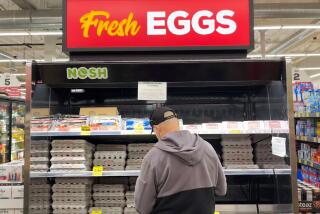Organic dairies test nation’s feed supply
- Share via
YAKIMA, WASH. — It comes as no surprise to anyone that the number of organic farms is booming to meet consumer demand for healthy food.
In Washington, a state known more for its apples than any other crop, there are 45 organic dairies. Five years ago, there were just two. The challenge has been feeding all of those cows.
Acreage of organic forage, such as hay and alfalfa, has grown 40% in the last two years, yet isn’t keeping pace with demand.
In particular, high-protein crops such as soybeans that are necessary feed for dairy cows are in short supply in some regions, forcing some companies to import them from as far away as China.
Given the recent problems with food and ingredient imports from China, in which a slew of products have been turned away by U.S. inspectors amid claims they are tainted, one might wonder if organic feed is actually organic.
“That’s a legitimate concern. We do have organic standards, which apply even to producers overseas if they want certification,” said Bill Freese, the Center for Food Safety’s science policy analyst in Washington, D.C. “But I think the oversight of organic standards to be sure there’s compliance is generally better in the United States than overseas.”
Organic products are grown without pesticides, fertilizer, hormones or antibiotics. They make up only a small slice, about 3%, of the nation’s food market, but increasing demand is pushing more farmers to make the switch in hopes of higher returns.
Dairy farmers are no exception. Demand for consumer organic dairy products has grown by more than 20% each year, a trend that is expected to continue at least in the near term.
The federal government also encouraged conventional dairy farmers to convert to organic operations by easing organic certification to reduce feed costs.
Under a federal rule, the farmers could feed their cows 20% conventional feed, which is less expensive, in the first nine months of operation. However, the rule expired Saturday and dairies across the country made the switch to beat the clock.
“So many people came on board at once, and the system didn’t know they were all going to go on board,” said Lynn Clarkson, board member of the national Organic Trade Assn. and president of Clarkson Grain Co. in Cerro Gordo, Ill. “You have to start with feed a year ahead of time or you’re not going to have it.”
Clarkson estimated that demand for organic feed was growing 20% each year, while U.S. production of organic row crops, such as corn and other feed, was growing only by about 4%. Add in the “ethanol tsunami” that is encouraging more farmers to grow corn for biofuel rather than feed, he said, and the shortage could continue for organic growers “for a long time.”
Shannon Andrews, a Portland, Ore., feed ingredient trader for San Francisco-based agricultural commodities distributor Wilbur-Ellis Co., said she couldn’t meet demand.
“I have customers that are looking for six railcars a month of corn, and I can’t get that quantity coming from anywhere in the U.S.,” Andrews said.
The harder-to-find, high-protein feed is coming from China and other countries because “it’s where you can get it,” she said.
Jay Gordon, a dairy farmer and executive director of the Washington Dairy Federation, believes that more feed crops need to be planted to meet local demand. He grows sunflower, canola and safflower on 700 acres in western Washington’s Chehalis Valley to feed his 104 organic cows.
The price for conventional canola meal runs from $150 to $170 a ton, but organic prices can reach $480 a ton. Crop farmers should recognize the potential in organics, Gordon said.
“There’s a lot of dairies that have decided they would not be in the business if not for organic,” he said. “This is a nice niche that’s fit well for dairy farming. We just have to go talk to our crop farmers.”
Agriculture officials in Washington state have already taken notice. State officials held two seminars in the spring to encourage more farmers to become certified as organic growers, including Jim Arvidson, who has a hay farm in Sunnyside, Wash.
“You lose some production because of the lack of ability to use commercial fertilizer or maintain weeds the way I normally would,” Arvidson said. But at the same time, he said, “There’s probably a 25%, maybe 30% increase for the organic feed. It’s good.”
More to Read
Inside the business of entertainment
The Wide Shot brings you news, analysis and insights on everything from streaming wars to production — and what it all means for the future.
You may occasionally receive promotional content from the Los Angeles Times.










